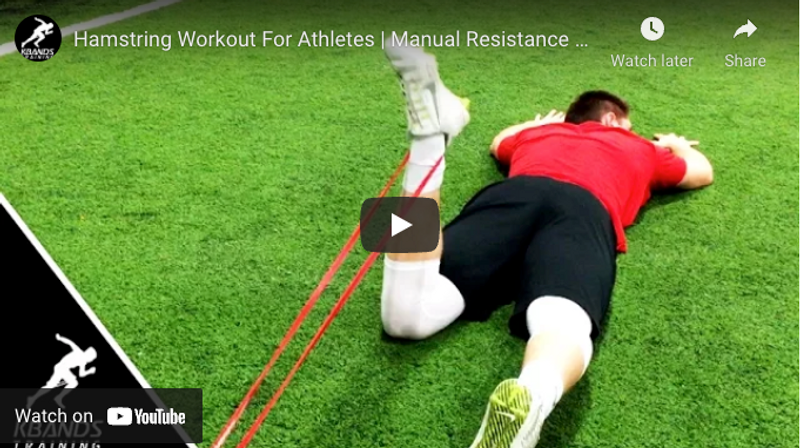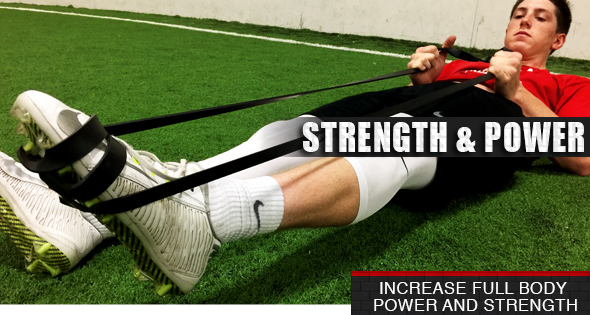Hamstring Workout For Athletes | Manual Resistance Hamstring Curls
The hamstrings are a group of muscles located on the back of the thigh. The different muscles of the hamstring control movements like flexion at the knee and rotation of the heel. The hamstrings work very closely with the quadricep and hip flexor muscles to help promote explosive and controlled movements.
Many athletes are in jeopardy of injuring their hamstrings, knees, or hips due to improper strength and flexibility in the hamstrings. When the hamstrings are underutilized it will force the quadricep and other upper thigh muscles to compensate and take more force than they are meant to withstand. Having weight go through the hamstrings will maintain healthy knees by keeping the tension of the movements in the posterior chain (glutes and hamstrings) and not allowing the tension to be placed in the quadriceps and knee ligaments.
Lying leg curls are one of the best exercises which can be used to strengthen the hamstring muscles. The angle created on the hamstring during the lying leg curl allows for controlled tension to be applied throughout the set of hamstring curls. Different variations of hamstring curls can be performed with the Ballistic Bands or the KB Duo.
Ballistic Band Hamstring Curls
To perform the Manual Resistance Hamstring Curls athletes will need a set of Ballistic Bands and enough space to lie flat on the ground. Athletes will also require an anchor for the lying leg curls. Athletes can either utilize a coach or partner to hold the Ballistic Band, or athletes can wrap the Ballistic Band around a stationery object to anchor the Ballistic Band during the Manual Resistance Hamstring Curls.
Athletes will begin the hamstring curls by laying flat on their stomach and wrapping the Ballistic Band around their ankle so the anchor is to the rear of the athlete. Athletes need to make sure there is enough distance between then and their anchor so proper tension can be maintained throughout the Manual Resistance Hamstring Curls.
Athletes will begin the hamstring workout by pointing their toe toward their shin flexing at their knee, bringing the heel as close to the butt as possible. Athletes will then perform the eccentric portion of the lying leg curl by extending the leg (taking the foot toward the ground) in a controlled manner. As athletes work through this hamstring workout they will want to continue to use a long range of motion as they flex and extend the knee during the lying leg curl.
Athletes will perform the Manual Resistance Hamstring Curls for 30 seconds on one leg, moving at a quick pace, and then perform another 30 second lying leg curl on their opposite leg. Athletes will perform 4-6 sets of the hamstring workout on each leg allowing 30-40 seconds of rest between sets of the Manual Resistance Hamstring Curls.
Creating An Effective Hamstring Workout
Timing and form are two important factors when trying to create an effective hamstring workout. Athletes should pair the Manual Resistance Hamstring Curls with additional leg exercises in a circuit style workout or performing additional leg strengthening exercises before and after the Manual Resistance Hamstring Curls have been completed. For additional leg strengthening exercises which can be performed with the Kbands Stability Ball, Ballistic Bands, or KB Duo go to the Training Section.
The placement of the Manual Resistance Hamstring Curls in the workout will play an important role in how effective the workout is for athletes. Athletes and coaches should perform the hamstring workout after speed training has been completed. The energy requirements for speed training are much greater and therefore more energy needs to be available in the muscles of the legs in order to have an effective speed training session. Also, if the hamstring muscles are fatigued it can lead to poor running and movement form which can lead to development of bad movement habits and potential injuries or decreased sports performance.
To make the Manual Resistance Hamstring Curls as effective as possible athletes need to focus on how their body is moving throughout the hamstring workout. Athletes and coaches need to watch the hips, low back, and upper body to ensure athletes are not leaning to the side or allowing the hips or thighs to come off the ground. These movements are the bodies way of compensating and trying to make the lying leg curl easier for the hamstring muscles. Avoiding these compensatory movements will allow more tension to be placed in the hamstring muscles creating more strength and mobility.
Advanced Hamstring Workouts
Athletes who have mastered the original version of the Manual Resistance Hamstring Curls can do a few things to increase the intensity of the lying leg curls. First, athletes can simply use a higher level of Ballistic Band to increase the intensity and tension placed on the hamstring muscles. Athletes and coaches can go to the Shop Section to learn about the different levels of resistance for the Ballistic Bands.
Athletes can also change the tempo of the hamstring workout to increase the intensity and effectiveness of the Manual Resistance Hamstring Curls. Instead of keeping the same quick tempo throughout the Manual Resistance Hamstring Curls athletes can go 5-10 seconds at a higher intensity, then alternate and spend the next 5-10 seconds going at a much slower controlled tempo. This change is tempo will force different muscles fibers to activate in the hamstring muscles as well as deplete the energy from the muscles.


